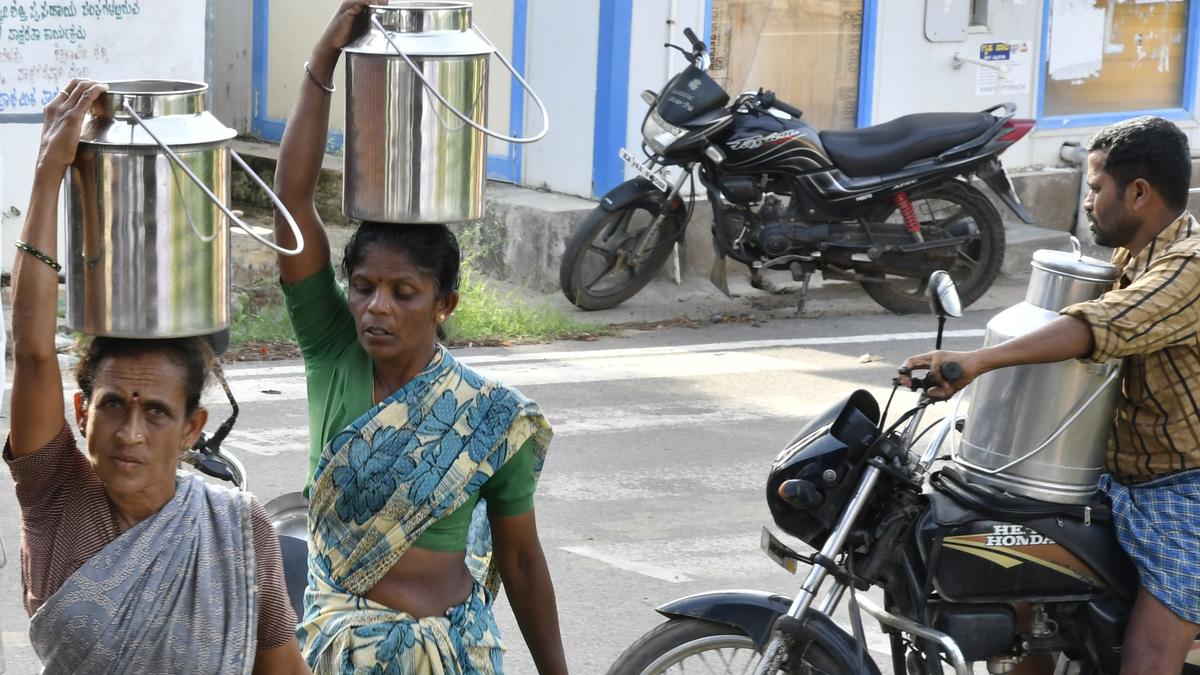
From plenty to parched: Dairy farmers’ struggle for survival
The Hindu
Drought in Karnataka impacts dairy farmers' income, milk production, and government subsidies, leading to financial distress and reduced milk yield.
Ravi., a dairy farmer in Keelara village in Mandya district in the heart of the Old Mysore region, has been able to earn a supplementary income from the cows that he rears and from the paddy he cultivates. However, the long spell of drought since last year forced him to sell two cows about six months ago because fodder has become difficult to procure.
He now has one cow to ensure milk supply to his own family and he is able to sell only a couple of extra litres to the local milk co-operative society. Though he has a borewell, the water yield has reduced so drastically that he cannot even grow green fodder. Purchasing fodder is out of the question because it is too expensive.
There are similar stories across Mandya, Kolar, Tumakuru, and Bengaluru Rural districts, which contribute the bulk of the Karnataka Milk Federation’s (KMF) milk procurement, along with Hassan, Mysuru, and Shivamogga districts in the State.
In Karnataka, about 24 lakh dairy farmers are members of village-level milk cooperative societies, and an unspecified number of non-members also rear cows in the State. The Old Mysuru region in south Karnataka has seen growth in milk production since the milk revolution started in the mid-70s. Affected by the vagaries of monsoon in rain-dependent arid and irrigated areas, dairy farming has brought supplementary income to the farming community, and women’s participation is also high.
The failed monsoon in 2023, which led to crop loss, has reduced post-harvest hay availability, while water scarcity has prevented farmers from growing green fodder, triggering a shortage of cow feed. Though the State government issued fodder kits containing seeds to farmers as a drought-mitigation measure, farmers complained that without water, the kit remained unused, and the green fodder wilted in many cases.
Karnataka is currently facing the worst drought in the last four decades, with 223 of the 236 taluks in the State being declared drought-hit. While the previous monsoon’s bountiful rainfall helped fill lakes and improve groundwater, which sustained farmers’ lives, the onset of summer has brought misery to rural households as a large number of water bodies and borewells have dried up or yielded less water.
Added to their problem is the delay in releasing the government incentive of ₹5 per litre. The government released the last tranche in November 2023, and farmers were hoping to use the subsidy, which was expected later, to counter drought-related financial distress.

“Writing, in general, is a very solitary process,” says Yauvanika Chopra, Associate Director at The New India Foundation (NIF), which, earlier this year, announced the 12th edition of its NIF Book Fellowships for research and scholarship about Indian history after Independence. While authors, in general, are built for it, it can still get very lonely, says Chopra, pointing out that the fellowship’s community support is as valuable as the monetary benefits it offers. “There is a solid community of NIF fellows, trustees, language experts, jury members, all of whom are incredibly competent,” she says. “They really help make authors feel supported from manuscript to publication, so you never feel like you’re struggling through isolation.”

Several principals of government and private schools in Delhi on Tuesday said the Directorate of Education (DoE) circular from a day earlier, directing schools to conduct classes in ‘hybrid’ mode, had caused confusion regarding day-to-day operations as they did not know how many students would return to school from Wednesday and how would teachers instruct in two modes — online and in person — at once. The DoE circular on Monday had also stated that the option to “exercise online mode of education, wherever available, shall vest with the students and their guardians”. Several schoolteachers also expressed confusion regarding the DoE order. A government schoolteacher said he was unsure of how to cope with the resumption of physical classes, given that the order directing government offices to ensure that 50% of the employees work from home is still in place. On Monday, the Commission for Air Quality Management in the National Capital Region and Adjoining Areas (CAQM) had, on the orders of the Supreme Court, directed schools in Delhi-NCR to shift classes to the hybrid mode, following which the DoE had issued the circular. The court had urged the Centre’s pollution watchdog to consider restarting physical classes due to many students missing out on the mid-day meals and lacking the necessary means to attend classes online. The CAQM had, on November 20, asked schools in Delhi-NCR to shift to the online mode of teaching.









